Context
Darkness is a fundamental resource required by biological systems. Artificial light can provide useful functionality to enhance the lives of humans, but the cost of this artificial light is damage to the darkness resource that is foundational to the lives of humans, wildlife, and the ecosystem. Therefore, light pollution must be restricted and regulated.
Car headlights and roadway streetlights exist for the same purpose. Therefore, car headlights cannot be some separate system that is not part of the light pollution issue. To protect the safety of drivers, the safety of pedestrians, the safety of wildlife and the health of all biological systems, we must regulate light pollution from vehicle headlights in conjunction with the light pollution from roadway streetlights.
Figure 1 lists five lighting metrics. More detailed descriptions of these metrics are discussed elsewhere. The unit for Luminance is also called “nits”.

History
The Ford Model A, built in 1903, had a top speed of 28 miles per hour.[f] Once headlights were added, they were not used so much for vision as they were to simply be visible to others at night.[f] The earliest cars literally used acetylene or oil lanterns that had to be lit by hand. For a vehicle driving on a country road, the vehicle would need to drive quite slowly at night, if at all. However, for a vehicle driving in New York City on Broadway, the new electric streetlights would allow the driver to see the road.[f]
At this early stage of vehicle lighting, the main purpose of the headlight was to let pedestrians know that a car was coming. There was a shared responsibility between both the pedestrian and the driver to avoid a collision.
The Ford Model T started coming off the assembly line in 1908. It had a top speed of 45 miles per hour. Figure 2 shows a Ford Model T parked under sodium lights with headlights turned on. There is a person crossing the road that is barely visible. The car could easily outrun the headlights, so it was up to the driver to drive at a speed that was safe.
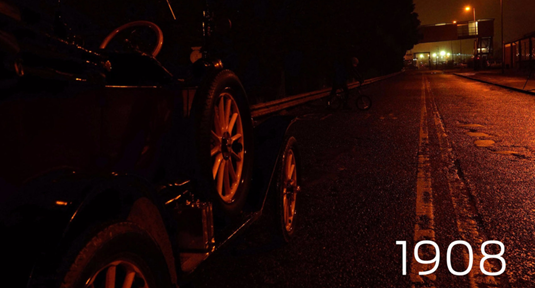
A car headlight in 1908 had a maximum luminous intensity of 30,000 candela[6] from the center beam. The beam angle was 10 degrees, so the light would be best described as a spotlight. The color temperature was approximately 2200 Kelvin, which is a soft orange.
By 1912, most car headlights were 21 candlepower.[f] This is a reference to spherical candlepower, so we multiply 21*4*pi to convert to 264 lumens of overall luminous flux.
Even though 264 lumens is not particularly bright, the first lighting regulation was adopted in Massachusetts in 19156. The regulation attempted to set a minimum level of brightness, but also a maximum level of glare. In other words, the issue of glare into the eyes of an oncoming driver or pedestrian was considered at least as far back as 1915.
As lighting improved and increased in brightness, glare to the oncoming driver or pedestrian also increased. In 1937, France attempted to control the glare issue by legislating yellow headlights to reduce glare and eye fatigue.[f]
The first sealed beam tungsten headlight was sold in 1940. This headlight had a maximum of 75,000 candela through the center beam and a beam angle of 10 degrees.
1983 saw the introduction of halogen sealed beam headlights with a typical low beam at 800 lumens and high beam at 1,200 lumens.
In 1992, High intensity Discharge lights were sold on some models. These HID lights have a high beam around 3,000 lumens. HID lights continue to be used by some manufacturers.
2004 saw the introduction of Light Emitting Diode headlights. Some vehicles use LEDs for Daytime Running Lights, while others use LEDs for both the DRLs and the main headlights. LED headlights can be anywhere from 3,000 to 10,000 lumen and a color temperature from 3000K to 8,000K.
2014 was the first year for laser headlights. BMW claims that their laser headlights can illuminate the entire road for almost half a mile.[f] The ability to light so much area at such great distances comes with consequences that will be further discussed in this section.
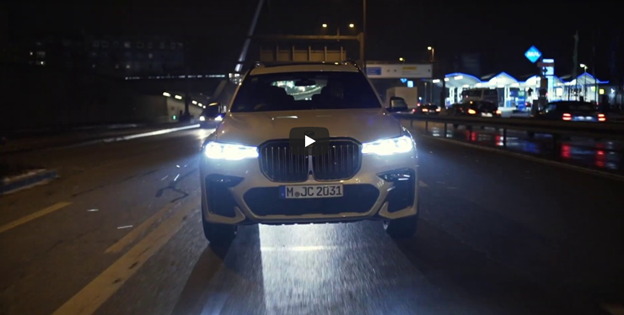
By 2015, Adaptive Driving Beam (ADB) headlight systems were widely available in Europe and are now being considered by NHTSA for the USA. These headlight systems use sensors, computers, and LEDs to direct the light to discrete locations.
Discussion
LED and HID headlights are too bright, according to many. For example, there is an online petition where tens of thousands of people have voiced their opinion that LED and HID headlights are painful, agitating, and dangerous.[f]
The excessive brightness may mean that is too much glare, or the color temperature is too high or that the luminance is too intense or maybe all three. Whatever the cause, these headlights are causing problems for drivers and the issues need to be addressed.
Issues
Light Pollution
Darkness is a critical resource that must be protected for the health, safety, and proper functioning of biological systems. Vehicle headlights are a source of light pollution that must be regulated to minimize its impacts on the dark environment.
One aspect of headlight pollution is called Glare. Human eyes are designed to use reflected light to view objects. A vehicle headlight that emits photons, especially high energy blue wavelength photons, directly into the eye causes the photons to bounce around within the retina, causing disabling glare. The result is a loss of image acuity for the scene and damage to the photoreceptors of the eyes.
Another aspect light pollution is Contrast, which is the difference between the dark night and the bright headlights. The greater the difference in contrast, the more effort your eyes go through to adapt to the changing light conditions. This effort results in muscle fatigue in the eye.
Light pollution in the form of high color temperature can be mentally torturous, especially for sensitive receptors. The high energy, blue wavelength light can cause anxiety, anger, agitation, and even thoughts of suicide. High color temperature light also increases disability glare.
Excess light from car headlights contributes to overall light pollution that damages the darkness resource and harms biological systems.
Sensitive Receptors
The emotional component of being hit in the eyes by high energy blue wavelength light cannot be overstated. The eyes are a very sensitive instrument and a person hit in the eyes with such high intensity light will be angry and agitated and may act aggressively. Repeated encounters with these high energy lights can lead to eventual mental collapse due to the similarity to torture.
A sensitive receptor may either hyper focus on a high color temperature light, become angry and agitated and may react destructively due to the fear induced by the blue wavelength light.
For example, Figure 4 shows a Cadillac with bluish, higher color temperature, Daytime Running Lights. These high color temperature LEDs can capture the eyes and mind of a highly sensitive person because the large spike of blue wavelength light makes the headlights stand out from the surroundings.
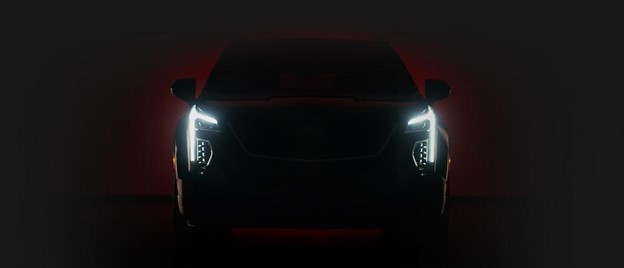
Glare
Glare is caused by a significant ratio of luminance between the task (that which is being looked at) and the glare source[f]. The National Highway Transportation Safety Administration has studied glare for many years, but NHTSA regulations have not kept pace with the latest technologies. A 2005 NHTSA report on glare has no mention of color temperature.[f]
Figure 5 shows an example of LED lights on the front of a vehicle. The blueish color tells us that the light contains high energy blue wavelength light which causes glare and light pollution. This light causes eye strain, reduced vision, and permanent eye damage.
Figure 6 shows another example of headlight glare at an intersection. There is little available relief for the person waiting at the intersection. The red signal lights force the driver to wait at the entrance to the intersection for the signal to change color to green. During the wait, the driver is being assaulted by disabling glare that is damaging their eyes and causing emotional distress.
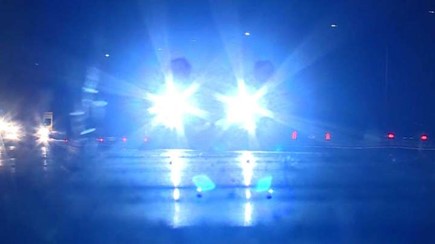
As we can see in Figure 6, these LED or HID headlights have far more glare than the older tungsten-halogen headlights visible in the vehicle to the left of the photo. The glare from HID can be 40% more glaring than tungsten-halogen for the same intensity level.[f] Since HID headlights are also more intense, the glare increase is even higher than 40%.
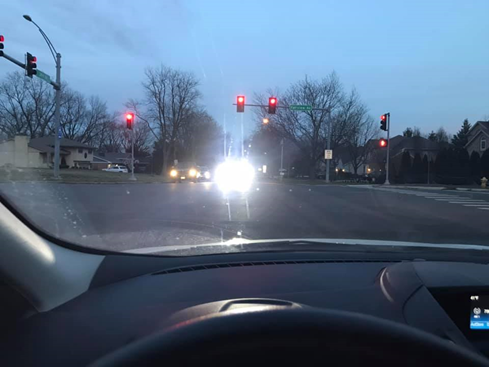
Being dazzled takes two seconds to recover from.[f] This means that, if a driver is dazzled by headlight glare from a single vehicle, it can two seconds to regain full vision. The driver is thus much less able to adapt to a hazard, and at 65 miles per hour, can cover significant distance while attempting to regain their sight. If we extend the dazzle issue to multiple vehicles, the driver may be permanently disabled by headlight glare while driving.
The glare is inherent in the OEM headlight system that uses 5000K-6500K LED or HID headlights. The high energy blue wavelength light causes significant disability glare, and any small rise or bump will direct the high energy light directly into the eyes of the oncoming driver. This glare can also be caused by misaligned headlights.
The issue of glare has been known since headlights were invented. However, when there were fewer people and vehicles or perhaps because there was more concern about the needs of others, there was a stronger emphasis on personal responsibility to adjust the headlights so as not to harm others. Consider the following quote:[f]

In our current situation, we rely more on technology to make the decisions for us. Therefore, the technology must consider the effect of glare to oncoming drivers, pedestrians, and wildlife.
Color Temperature
To illustrate the effects of color temperature, witness the following true story.
Wallace always had to be the passenger because the of the emotional anguish he feels when hit by high color temperature car headlights. One day, his partner was driving, and Wallace was looking down at a map. Wallace looked up and was hit full force in the eyes by a 5000 Kelvin color temperature headlight from a motorcycle that was rounding a curve and was now only a few yards from their car.
The surprise, shock and intensity of the blinding light was so severe that Wallace nearly threw himself out of the car. His partner kept saying to him, “Be strong. I need you. Be strong.” as Wallace wailed and screamed and held his hands to his head.
The cause of Wallace’s agony was the high energy, blue wavelength light that is 10 times more damaging to the eye than red wavelength light.22 The amount of blue wavelength light from a light source can be approximated using color temperature. LED and HID headlights have large spikes of dangerous blue wavelength light.
Color temperature was previously rarely discussed regarding vehicle headlights because the carbon-based lights emitted a candle-like like that humans were comfortable viewing. With the invention of LED and HID lights, color temperature has become a major concern due to the negative impacts of high energy, blue wavelength light on the human eye.
Both an incandescent light[f] and a halogen sealed beam headlight[f] have color temperatures in the 2500K range. HID and LED headlights are often in the 5000K to 6500K range. This means that LED and HID headlights emit a strong spike of blue wavelength light that can be distracting, cause emotional anxiety, and damage the eye.
Figure 7 shows a vehicle with high color temperature headlights. The blue color indicates high energy blue wavelength light that is damaging to the eyes.

Brightness
The word “brightness” does not have a scientific basis but is used to communicate to others a property of light and how that light affects human perception. When a person says, “That light is too bright!”, they may be referring to the total luminous flux, or the luminous intensity, or the color temperature or spectral power distribution or the contrast or some combination of these variables.
As an example of brightness, a 2007 Toyota Tundra tungsten-halogen headlight measures 530 lux of luminous flux at 25 feet on low beam.[f] Whether this is “bright” or not depends on many factors such as those listed above, but also the sensitivity of the eye of the viewer. Another example of a headlight is 8400 effective lumens, 13,500 raw/actual lumens and distance to 1 lux of 1,768 meters.20 The center beam of 100 watt incandescent is 220 candela.1
A high color temperature light can be described by a viewer as “bright” because the blue wavelength light has more energy and produces more glare.
Human Eyes
Figure 8 demonstrates the power of our technology. The road is well illuminated for a great distance by the car headlights. However, this level of illumination comes at a cost.
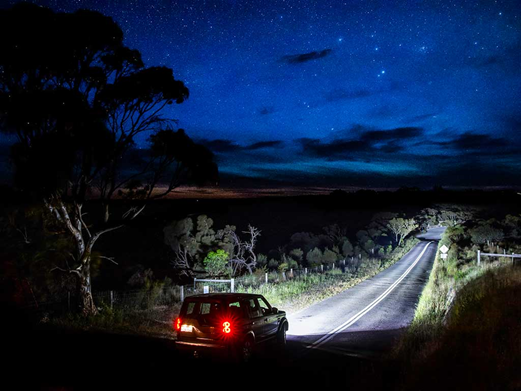
First, the intense light reflects off surfaces and returns into the driver’s eyes which leads to eye exhaustion and possibly eye damage if the light is a high color temperature. In addition, because of the high contrast between the bright center and dark edge, the eye is further taxed trying to continuously switch between the bright light and low light conditions.
Second, oncoming drivers and pedestrians would be blinded by the high intensity light. The light would create disability glare in their eyes, cause cell damage, and reduce vision. The emotional component of being assaulted directly in the eye by a bright light is significant and the driver or pedestrian may attempt to retaliate.
The illumination of an object in lux is not a measure of the photochemical damaging power of the light. The lumen value contains no information about whether the light flux is dominated by energy in the luminously inefficient, but photochemically efficient, blue wavelength or, as with a tungsten lamp, is largely provided by luminously inefficient but photochemically relatively harmless radiation at the red end of the spectrum.[f]
One can expect very roughly ten times faster damage by blue radiation at 400+ nm than by an equal power of light in the yellow green region at 550 nm.[f]
Constant exposure to different wavelengths and intensities of light promoted by light pollution may produce retinal degeneration because of photoreceptor or retinal pigment epithelium cells death.[f]
The retina is capable of accommodating a contrast ratio of approximately 100:1, while pupil dilation will react to brightness that fills a significant area of the visual field, up to 100:1[f] When exposed to bright headlights on a dark night, the pupil will expend energy opening and closing to accommodate the differing brightness levels.
According to a review of research literature, ambient lighting on the roadway at night is approximately 1 nit and the driver of a vehicle should be subject to brightness levels from other sources that do not exceed 10 to 40 times that amount.[f] Therefore, car headlights should not exceed approximately 40 nits at the eye.
Safety
For safe driving at night, we need to understand the connection between the speed at which the vehicle is traveling, luminous intensity of the vehicle headlights, and the luminous intensity of streetlights and other external lighting. These factors affect not only the safety and the eyes of the driver of the vehicle, but also the safety of oncoming drivers, pedestrians, and wildlife. The cumulative light pollution also affects sleep and circadian rhythms.
An estimated 38,800 people died in car crashes in 2019.[f] Roughly 93% of all car accidents are due to human error.[f] Studies show that for every 5 miles per hour increase in highway speed limits, fatalities increased by almost 9%.[f] What this all tell us is that vehicle safety is more dependent on the speed of the vehicle than the brightness of the headlights.
Figure 9 shows an example of LED lights illuming not only the lane where the car is travelling, but also the oncoming lane and the shoulders of both lanes. This excessive brightness and high color temperature lead to eye exhaustion for the driver. Worse, the high intensity light will blind oncoming drivers, pedestrians, bicyclists, and wildlife.
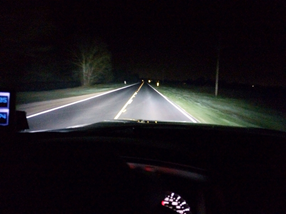
Figure 10 shows a pedestrian walking across the road with no overhead illumination in the first frame, low levels of overhead illumination in the second frame, and bright overhead illumination in the third frame.

Since the pedestrian is now more visible in the third frame, the tendency has been for engineers and governments to conclude that the best way to prevent accidents is to brightly light all the streets. However, due to the issue of contrast, solely increasing the target luminance will not improve the visibility conditions.[f] For example, high color temperature LED headlights may make the scene brighter, but the glare from the high energy blue wavelength light makes decision making more difficult for the pedestrian and oncoming drivers. The false conclusion that brighter is always better has led to more light pollution, impaired health of humans and wildlife, and an increase in dangerous conditions.
Technology
Headlight technology has changed significantly since the original headlights began appearing on cars in the early 1900s. To help us understand how headlights are evaluated, let us take a look at how light beam patterns are measured.
Figure 11 is called an isocandela plot. The left/right axis is the horizontal degrees. The up/down axis is the vertical degrees. The colors represent candelas. In the center of the beam, the brightness is about 30,000 candelas. The 50% cutoff for intensity is very near the center, so the apex angle is only 10 degrees. For a typical sealed beam headlight on low beam at 800 lumens, this is about 30,000 candela peak intensity. High beam is about 50,000 candelas. The color temperature of a sealed beam headlight is about 2700 Kelvin.
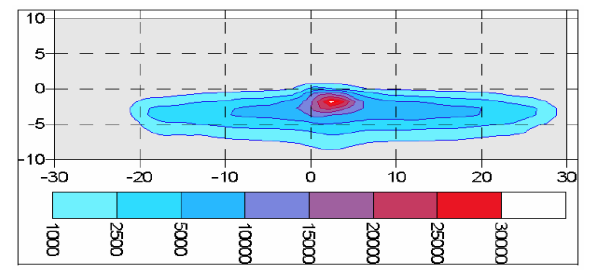
Cat Eyes
Cat eyes can be used as guide markers on the road. These markers can assist automated driving systems know where the edge of the road is and where the lane edges are. For non-automated driving, cat eyes may encourage drivers to go faster and accident rates increased.[f]
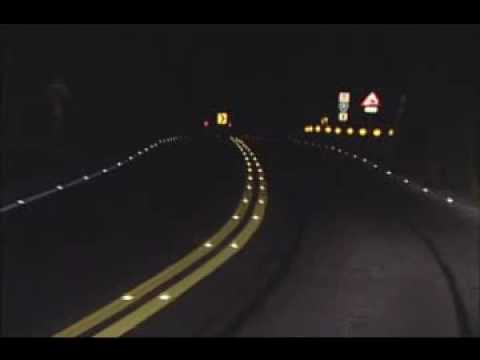
Note in Figure 12 that the vehicle is emitting relatively low levels of light. The reflective markers provide information to the driver that assists the driver in navigating the roadway without blinding oncoming drivers or pedestrians.
Light Emitting Diode
LED headlights produce a bright intense beam from a small source. The use very little energy and can be placed into many shapes. Without a diffusion covering, multiple LED lights can look like small dots of light which can be more distracting. The high color temperature of LED headlights causes glare and the intensity can lead to mind capture, especially for sensitive receptors.
LEDs are up to 300% brighter than standard halogen bulbs.[f] A 2018 study by the Royal Automobile Club stated that two-thirds of motorists have been dazzled by oncoming headlights.[f] The number of complaints about dazzle have been increasing since the introduction of LED and HID headlights.
High Intensity Discharge
HID headlights, also known as Xenon headlights, use a bulb filled with gas and an electrical arc to excite the gas to emit a high intensity light.[f]
Projector Headlights
Projector headlights are high-performance headlights that were originally only available in luxury vehicles. They are capable of using extremely bright high-intensity discharge (HID) and light-emitting diode (LED) bulbs that would be unsafe to use with traditional reflector headlights.[f] Figure 13 shows an example of a projector headlight housing.
Figure 13 – Projector Headlight
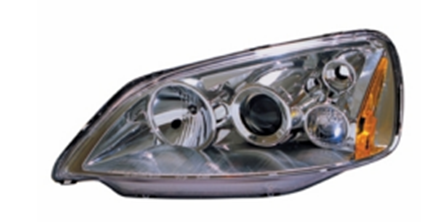
The beam pattern for a projector headlight may not result in the center beam being the most intense. As shown in Figure 14, the point where beams cross will be a hot spot and will be the brightest measured location. For this and other reasons, using luminous flux or luminous intensity measurements from the source will not be sufficient to determine that highest level of luminance that hits the eye.

Infrared, Radar and Lidar
Visible light is not the only method of seeing. We can use other sections of the electromagnetic spectrum as well.
Infrared light is not visible to the human eye and can be used to see in the dark. However, at high enough energies, infrared can damage the eye. Therefore, there are power limits to distance limits for IR use.[f]
Automatic Emergency Braking
AEB systems use sensors to detect an impending crash. The computer will then automatically notify the driver or begin the braking process to prevent a collision.[f] AEB will be standard on all vehicles from 20 manufacturers by 2022.[f] Because of the widespread adoption of AEB, we can now reduce our reliance on bright headlights to keep us safe.
Adaptive Driving Beam
ADB systems have been available in Europe since before 2015. The National Highway Transportation Safety Administration, NHTSA, has released a proposal to approve ADB in the United States.[f] Figure 15 shows an adaptive driving beam headlight system.
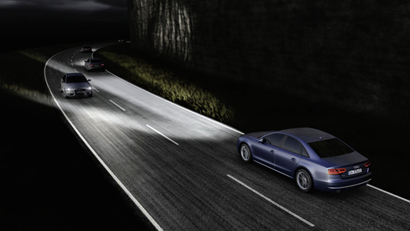
The ADB system uses discrete lighting components and/or shutters to illuminate only sections of the road to reduce glare to oncoming drivers or pedestrians.
Proposed Regulations
Darkness is a fundamental resource that is needed for the proper functioning of biological systems. Anthropogenic artificial light damages the darkness resource and therefore must be limited and regulated. We propose that vehicle headlights, taillights, and other light emitters be regulated as light pollution.
The original purpose of vehicle lighting was essentially to announce to pedestrians and others that a fast-moving vehicle was approaching. Over the years, the main purpose of vehicle headlights has changed. Now, the focus for vehicle lighting is on brighter lighting that illuminates longer distances so that vehicles may travel faster.
Concurrent to the increase in headlight brightness is the installation and use of bright streetlights. The general trend has been to increase the brightness of streetlights in the belief that brighter equals safer. The result has been an increase in light pollution and an increase in damage to the darkness resource. The light pollution has led to harm of biological systems. However, we can reduce light pollution and simultaneously improve safety by taking a holistic approach to lighting and utilizing sensors and computer technology.
Vehicle manufacturers use a system called Automatic Emergency Braking to automatically reduce vehicle speed to prevent a collision. This system uses sensors to detect roadway hazards and vehicle speed and powerful computers to analyze the information. The AEB system will automatically slow down or brake as necessary to prevent a crash.
Since AEB will be standard on nearly all vehicles by 2022, we can make use of this technology to reduce light pollution and increase safety. We propose that we return automotive lighting to its original intent of alerting pedestrians and others that a vehicle is approaching and that we eliminate the concept of using bright visible spectrum lights to allow the driver to go faster. Instead, we can use the existing AEB structure to allow the car to see long distances and roadway hazards.
We propose the following light pollution regulations.
- Set a maximum color temperature of 2700 Kelvin and set a minimum Spectral G-Index of 1.56 for all vehicle headlight systems.
- Require that all headlight systems have a diffusion covering that blends light emitters into a single source.
- Set a maximum luminance of 50 nits at all distances and angles from the headlight system. The reason we need to specify “at all distances” is because headlight systems may have hot spots that are beyond the source. Multiple beams could converge at near or great distances. By specifying 50 nits “at all distances” and “all angles” we ensure that the human eye is protected in all cases.
- Set a maximum luminance of 20 nits for vehicle taillights.
- Prohibit all strobing, flashing and blinking lights other than turn signals and hazard lights. Turn signals and hazard lights must not exceed 20 nits and flash no faster than 1 hertz.
- Prohibit Daytime Running Lights and other lights during the day to reduce driver distraction.
- Require that the AEB system prevent a vehicle from traveling faster than is safe.
- Require that all vehicles be evaluated for light pollution violations every two years using the existing California Smog Check network.
Additional References
- https://www.iihs.org/topics/headlights
- https://www.consumerreports.org/cro/news/2015/05/guide-to-car-headlight-technology/index.htm
- https://www.ccs-labs.org/bib/memedi2018impact/memedi2018impact.pdf
- https://www.ies.org/definitions/center-beam-candlepower-cbcp/
- https://en.wikipedia.org/wiki/Standard_illuminant
- https://www.sciencedirect.com/topics/engineering/luminous-intensity
- https://www.lec-expert.com/topics/units-of-light
- https://www.onallcylinders.com/2015/02/27/light-source-quick-guide-automotive-lighting/
- https://www.pro-lite.co.uk/File/LAB%20TechGuide%20-%20LED%20Measurements.pdf
- https://www.onsemi.com/pub/Collateral/TND328-D.PDF
- https://dot.ca.gov/-/media/dot-media/programs/research-innovation-system-information/documents/preliminary-investigations/digital-display-safety-pi-a11y.pdf
- https://reader.elsevier.com/reader/sd/pii/S2351978915008732